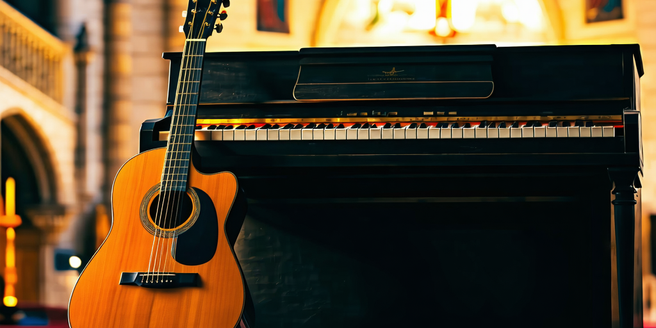The Power of Music in Emotional Healing
| Component | Impact | Example |
| Melody | Calms the mind | Soothing piano pieces |
| Rhythm | Boosts energy | Upbeat dance tracks |
| Lyrics | Connects emotionally | Inspirational ballads |
| Harmony | Encourages introspection | Choral music |
| Tempo | Regulates heartbeat | Relaxing ambient tracks |
| Dynamics | Expresses emotions | Classical symphonies |
How Worship Strengthens Spiritual Well-being
Worship is a profound pillar in nurturing and strengthening spiritual well-being, serving as a transformative practice that reconnects individuals with their inner selves and a higher power. It provides a sacred space for reflection, allowing people to express gratitude, seek guidance, and confront personal challenges with renewed perspective. Engaging in worship fosters a sense of community and shared purpose, reducing feelings of isolation by reminding individuals that they are part of a greater whole. This communal aspect can enhance emotional support networks, further enriching one’s spiritual journey.
Moreover, worship cultivates mindfulness; it invites participants to be present, focusing their thoughts and energies away from everyday stressors. This mindful presence can lead to greater peace, resilience, and clarity. As individuals immerse themselves in worship, they often experience an elevation in hope, faith, and purpose, empowering them to navigate life’s complexities with grace and strength.
Exploring the Science Behind Music Therapy
Music therapy has increasingly gained attention in recent years as a valuable tool for improving mental health and enhancing overall well-being. At the core of music therapy is its ability to evoke emotional responses, often by eliciting memories and feelings associated with particular sounds or songs. Neuroscientific research has shown that music activates various areas of the brain, including those responsible for emotion, memory, and even motor skills. This happens because music triggers the release of neurotransmitters such as dopamine, known for its role in mood regulation and pleasure.
Furthermore, rhythm and melody can impact our physiological state by influencing heart rate and breathing patterns, fostering relaxation and stress reduction. These effects are harnessed by music therapists to help individuals cope with challenges like anxiety, depression, and trauma. They tailor sessions to individual needs, selecting musical elements that resonate most profoundly with each client, thereby facilitating a healing process that is both scientifically grounded and deeply personal.
The Role of Worship in Community Healing
Worship plays a pivotal role in community healing by fostering unity, offering solace, and promoting collective resilience. In times of crisis or conflict, communities often seek solace within their spiritual circles. Worship gatherings provide a sacred space where individuals can express their hopes, fears, and gratitude collectively. Through shared rituals, music, and prayers, worship fosters a sense of belonging and reinforces interconnectedness among members.
Moreover, worship acts as a catalyst for emotional and psychological healing. The act of coming together in reverence allows individuals to find peace in shared spirituality, helping them cope with personal and communal grief. The communal experience of worship reminds members that no one is alone in their struggles, thus nurturing empathy and compassion.
In addition, worship encourages active community involvement and outreach. By promoting values of service and generosity, worship inspires members to support one another, creating a stronger, more resilient community capable of overcoming adversity through collective efforts and restorative practices.
Personal Stories of Healing Through Music
Music has long been a universal language, transcending cultural and linguistic barriers to reach the very core of human experience. Personal stories of healing through music reveal how powerful melodies and harmonies can mend what is broken within us. For instance, consider the story of Sarah, who, after losing her father, found herself adrift in a sea of grief. It wasn’t until she began attending a local community choir that she rediscovered a sense of purpose and belonging. Through singing, Sarah was able to express emotions that words alone could not capture, gradually finding solace and strength in the communal act of creating music. Each rehearsal was a step in her healing journey, the notes and lyrics guiding her back to herself. Stories like Sarah’s highlight the profound impact of music as a healer, bridging gaps between pain and peace.
Creating a Worshipful Environment for Recovery
Creating a worshipful environment for recovery involves crafting a sacred space where individuals can reconnect with themselves and a higher power, fostering both healing and growth. This environment is not limited to a physical location but extends to the emotional and spiritual atmosphere created by the community and the practices within it. Incorporating elements such as calming music, inspiring artwork, and quiet spaces for reflection can aid in soothing the soul and encouraging introspection. Rituals like prayer, meditation, or communal gatherings can offer structure and support, allowing individuals to find peace and a sense of belonging. Moreover, integrating teachings and scriptures that emphasize forgiveness, hope, and resilience can inspire personal transformation. A worshipful environment emphasizes unconditional love, acceptance, and encouragement, echoing the divine grace believed to support everyone on their journey towards recovery and wholeness.
Combining Music and Prayer for Inner Peace
In today’s fast-paced world, finding moments of inner peace can be challenging. However, the harmonious blend of music and prayer offers a powerful sanctuary for the soul. Music, with its universal language, has the ability to transcend barriers, reaching the deepest corners of our hearts. When combined with prayer, this fusion becomes a potent tool for introspection and emotional release. Just as prayer offers a dialogue with the divine, music acts as a bridge, lifting our spirits and centering our thoughts. Different traditions have harnessed this combination for centuries, from the Gregorian chants in Western Christianity to the Sufi whirling accompanied by hypnotic rhythms in Islam. By integrating soothing melodies with spoken or silent prayers, individuals can create a personalized ritual that calms the mind, promotes mindfulness, and fosters a profound sense of connection to something greater than oneself.
The Impact of Worship on Mental Health
Worship, a cornerstone of many religious and spiritual practices, can significantly impact mental health in profound and positive ways. Engaging in worship creates a sense of community and belonging, which can help combat feelings of isolation and loneliness. Gathering with others to share beliefs and practices fosters a supportive network, offering emotional and social support that can enhance overall well-being.
Moreover, worship often involves rituals, music, and meditation, all of which have been shown to reduce stress and anxiety. These practices can promote relaxation, decrease cortisol levels, and increase the production of feel-good neurotransmitters like serotonin and dopamine. Additionally, the structure and routine of worship provide stability and predictability, which can be comforting in times of uncertainty.
For many, worship also fosters a deeper sense of purpose and meaning in life, guiding individuals through personal challenges and improving resilience by offering a broader perspective and spiritual encouragement.
Choosing the Right Music for Healing Purposes
When it comes to selecting music for healing purposes, the key is to find pieces that resonate with your emotional and psychological needs. Music has the profound ability to evoke emotions, reduce stress, and promote a sense of well-being, making it a valuable tool in healing. Start by exploring genres known for their calming effects, such as classical, ambient, or nature-inspired music. These types often feature soothing melodies and gentle rhythms that can help slow down the heart rate and reduce anxiety. Additionally, consider the cultural and personal significance of certain music. For instance, if certain sounds remind you of positive times or places, they might be more effective in lifting your spirits. Experiment with different tempos and instruments, and pay attention to how your body responds. Remember, the right music for healing is wholly personal, so trust your instincts and let your emotional response guide you.
Achieving Balance Between Music and Worship
Achieving balance between music and worship in a religious setting is a delicate yet rewarding endeavor. Music has always played a pivotal role in worship, serving as a conduit for spiritual expression and communal connection. However, finding the right balance ensures that music enhances the worship experience without overshadowing the spiritual intention.
To achieve this balance, one must first recognize the purpose of music in worship. It is not merely a performance but a form of prayer and a method to uplift and unify the congregation. Selecting appropriate music that resonates with the beliefs and values of the community is crucial. It’s essential that the tempo, lyrics, and style of the music align with the desired atmosphere of the service.
Involving congregational feedback can also guide the musical choices, ensuring that the music resonates deeply with the worshipers. Finally, the collaboration between musicians and worship leaders should emphasize worship, creating an enveloping and inclusive environment where music and spirituality coexist harmoniously.










